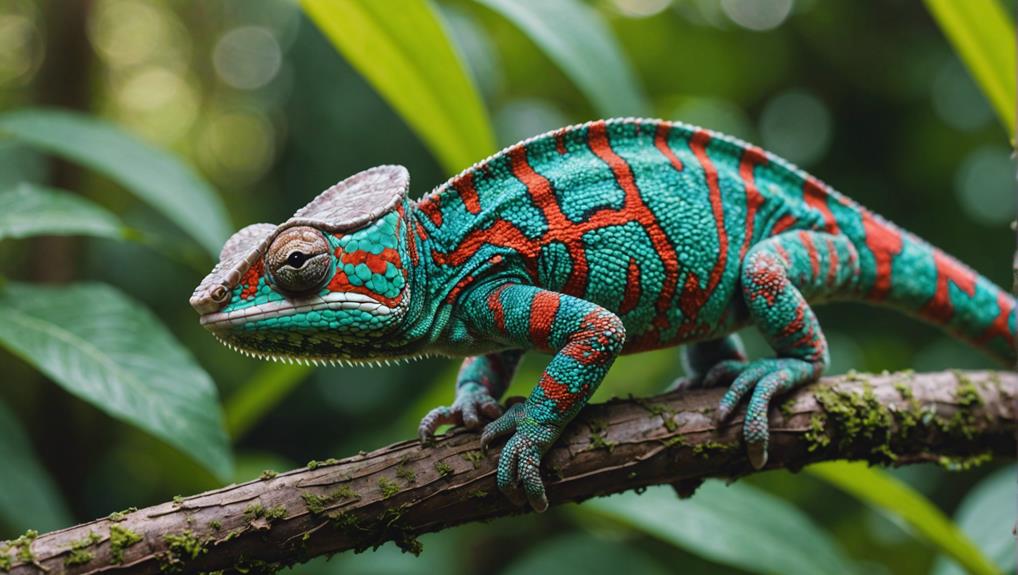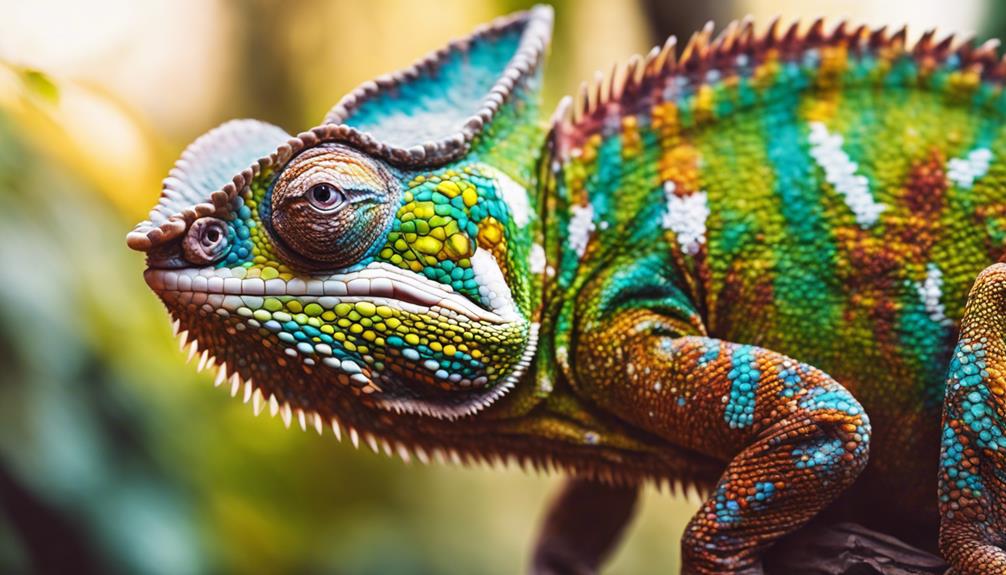The Carpet Chameleon is a stunning pet.
To provide the best care for your carpet chameleon, you'll need a spacious, well-ventilated vertical enclosure, ideally 18x18x36 inches.
Temperature-wise, aim for 75-85°F during the day, with a slight drop at night, and maintain humidity levels between 50-70%.
In terms of setup, include ample climbing branches and live plants to create a natural environment.
For lighting, combine UVB with a basking spot of 85-90°F.
A varied diet of gut-loaded insects, dusted with calcium, will keep your pet healthy and thriving.
Regular handling should be gentle and brief, while monitoring for potential health issues like respiratory problems or metabolic bone disease is a must.
Regular veterinary check-ups are essential to guarantee your chameleon's well-being.
Habitat Setup
To set up a suitable habitat for your carpet chameleon, you'll need to focus on providing a spacious and well-ventilated enclosure.
Start by selecting an appropriate enclosure size. Carpet chameleons thrive in larger spaces, so aim for at least 18x18x36 inches. This gives them plenty of room to explore and exhibit natural behaviors. A vertical space is essential because they love to climb.
Ventilation is another vital aspect. Proper airflow helps maintain a healthy environment and reduces the risk of mold and mildew. Screen enclosures are ideal, but if you prefer glass, make certain it has sufficient ventilation panels.
The substrate at the bottom of your chameleon's enclosure plays a key role in maintaining hygiene and replicating their natural habitat. Avoid substrates like sand or gravel, as these can be ingested and cause health issues. Instead, opt for organic options like coconut fiber or reptile-safe soil. These substrates aren't only safe but also help maintain humidity levels, which is vital for your chameleon's well-being.
You'll also want to provide plenty of climbing opportunities. Use branches, vines, and plants to create a dynamic environment. Live plants can enhance the enclosure by improving air quality and offering additional hiding spots.
Temperature and Humidity
To keep your Carpet Chameleon healthy, you'll need to focus on the right temperature and humidity levels.
Aim for a temperature range of 75-85°F during the day and a slight drop at night.
Additionally, maintaining proper humidity around 50-70% is essential for their well-being.
Ideal Temperature Range
Maintaining the right temperature and humidity is essential for keeping your carpet chameleon healthy and stress-free. Carpet chameleons thrive in a temperature range that mimics their natural habitat. Daytime temperatures should be between 75-85°F (24-29°C), with a basking spot that reaches up to 90°F (32°C). Nighttime temperatures can drop to 65-70°F (18-21°C).
When setting up your chameleon's enclosure, it's important to take into account their behavioral patterns and substrate choices. A temperature gradient allows your chameleon to regulate their body temperature by moving between warmer and cooler areas. Use a combination of live plants and safe substrates to create a natural environment that encourages these behaviors.
Here's a quick reference table for the ideal temperature ranges:
| Time of Day | Temperature Range | Basking Spot |
|---|---|---|
| Daytime | 75-85°F (24-29°C) | Up to 90°F (32°C) |
| Nighttime | 65-70°F (18-21°C) | N/A |
| Ambient | 70-75°F (21-24°C) | N/A |
| Substrate | 70-75°F (21-24°C) | N/A |
| Humidity | 50-70% | N/A |
Maintaining these temperatures guarantees your carpet chameleon remains active and stress-free. Use a reliable thermometer and hygrometer to monitor the conditions and make adjustments as needed.
Maintaining Proper Humidity
Essential humidity levels are imperative for your carpet chameleon's health and overall well-being. Maintaining proper humidity isn't just about keeping your pet comfortable; it's essential for their respiratory system and skin shedding process. Aim for a humidity range of 50-70%. This range mimics their natural habitat and helps prevent health issues.
Humidity fluctuations can be harmful, so it's important to keep the environment stable. To achieve this, monitor the levels using a reliable hygrometer. If you notice the humidity dropping too low, increase the misting frequency. Mist the enclosure 2-3 times daily to maintain the ideal conditions. Use a fine mist to avoid over-saturating the habitat, which can lead to mold growth.
Additionally, consider using live plants in the enclosure. They not only enhance the visual appeal but also help maintain humidity. Make sure the substrate is moisture-retentive but not waterlogged. You can also use a dripper system to provide a consistent water source, aiding in humidity control.
Lighting Requirements
When setting up your carpet chameleon's habitat, proper lighting is vital.
You'll need to provide the right light intensity and make certain they get adequate UVB exposure.
This helps them synthesize Vitamin D3, which is essential for their health.
Temperature is also crucial, with a basking spot of around 85-90°F (29-32°C) and a cooler area around 75-80°F (24-27°C) for thermoregulation.
A temperature gradient allows your carpet chameleon to regulate its body temperature as needed.
Humidity is another critical aspect of their habitat, with a relative humidity of 50-60% recommended.
You can increase humidity by misting the enclosure with water daily or using a humidifier.
A well-ventilated enclosure is vital to prevent respiratory issues, so ensure good airflow by providing adequate ventilation.
Avoid placing the enclosure in a drafty area or near air conditioning vents.
Substrate, or flooring material, is a crucial aspect of your carpet chameleon's habitat.
You can use reptile carpet, indoor/outdoor carpeting, or paper towels, but avoid gravel, sand, or wood shavings as they can cause impaction.
Plants can enhance the habitat and provide hiding places, but choose plants that are safe for your carpet chameleon to ingest in case they decide to nibble.
Some safe options include Pothos, Dracaena, and Philodendron.
Water and hydration are essential for your carpet chameleon's health.
Provide a shallow water dish for drinking and mist the enclosure daily to encourage hydration.
A hiding place or two can help reduce stress and provide a sense of security for your carpet chameleon.
You can use commercial hiding places or create your own using rocks, plants, or other decorations.
Climbing structures are a must, as carpet chameleons are arboreal and need to climb.
You can use commercial climbing structures or create your own using branches or other materials.
Finally, keep the habitat clean by removing feces and uneaten food daily and cleaning the water and food dishes regularly.
A clean habitat will help keep your carpet chameleon healthy and thriving.
Optimal Light Intensity
To guarantee your carpet chameleon thrives, you need to provide a well-balanced lighting setup that mimics natural sunlight. Light intensity plays a vital role in maintaining their health and well-being.
Your chameleon's enclosure size is important, as it influences how you set up your lighting. For a smaller enclosure, you'll need to be more precise with light placement to facilitate the entire space being adequately lit. For larger enclosures, you might need multiple light sources to cover the entire area.
When it comes to plant selection, choose plants that can thrive under the same light conditions as your chameleon. This not only creates a natural environment but also confirms that the plants contribute to maintaining humidity levels and providing hiding spots.
Aim for a light intensity that replicates the bright, dappled sunlight found in their natural habitat. Use a combination of basking lights and full-spectrum lights to achieve this.
Position the basking light to create a gradient of light intensity, allowing your chameleon to move between warmer and cooler areas as needed. Remember, the key is balance; too much light can stress your chameleon, while too little can lead to health issues.
UVB Necessities
UVB lighting is essential for your carpet chameleon's health, aiding in calcium absorption and preventing metabolic bone disease. Without proper UVB exposure, your chameleon can't synthesize vitamin D3, vital for calcium metabolism. To guarantee your pet thrives, you'll need to invest in high-quality UVB bulbs.
Choose UVB bulbs that emit the correct wavelength, typically around 5-10% UVB output. Position the bulbs about 8-12 inches above your chameleon's basking spot. This setup mimics their natural environment, providing the necessary UVB exposure. Be sure to replace the bulbs every six months, even if they still emit light, as their UVB output diminishes over time.
Monitor the duration of UVB exposure. Aim for about 10-12 hours of light per day to simulate natural daylight cycles. Using a timer can help maintain consistency, confirming your chameleon gets the right amount of UVB without daily hassle.
Dietary Needs
Carpet chameleons thrive on a varied diet primarily consisting of live insects like crickets, roaches, and worms. To provide your chameleon with the nutrients it needs, you'll want to focus on gut loading these insects before feeding them. Gut loading involves feeding the insects nutrient-rich foods, like leafy greens and fruits, which then pass on those nutrients to your chameleon. This step is essential for maintaining your pet's health and well-being.
When it comes to feeding frequency, adult carpet chameleons typically eat every other day, while younger chameleons may require daily feeding. The quantity can vary, but a good rule of thumb is to offer enough insects that your chameleon can consume within 15-20 minutes. If you see leftover insects, reduce the number next time.
Hydration habits are equally important. Carpet chameleons often prefer drinking water droplets from plant leaves rather than from a bowl. To mimic their natural environment, mist the enclosure twice a day. Consider using a dripper system to provide a steady source of water droplets. Your chameleon will appreciate the opportunity to drink whenever it feels the need.
Supplementation is another key aspect of their diet. Dust the insects with calcium powder every other feeding and use a multivitamin supplement once a week. This helps prevent deficiencies and supports overall health. Remember, balance is key; too much or too little supplementation can lead to health issues.
Handling and Interaction
While providing a nutritious diet is essential, knowing how to properly handle and interact with your carpet chameleon is equally important for fostering a healthy relationship. Carpet chameleons are delicate creatures and can become stressed if mishandled. Understanding their social behavior and using effective bonding techniques can help create a more positive experience for both you and your chameleon.
To start, always approach your chameleon slowly and calmly. Sudden movements can easily frighten them. When you first begin handling, it's best to do so in short, gentle sessions. Allow your chameleon to climb onto your hand rather than picking them up abruptly. This encourages them to feel secure and in control, fostering trust.
Here's a simple guide to handling and interacting with your carpet chameleon:
| Step | Action | Purpose |
|---|---|---|
| 1 | Approach slowly | Reduces stress |
| 2 | Offer your hand | Encourages voluntary climbing |
| 3 | Limit sessions to 10-15 minutes | Prevents overstimulation |
| 4 | Observe body language | Guarantees comfort and safety |
| 5 | Provide gentle, consistent handling | Builds trust and strengthens bonding |
Pay attention to your chameleon's body language. If they puff up, hiss, or change color dramatically, it's a sign they're stressed and need a break. Respecting these signals is vital for positive interaction.
Bonding techniques such as hand-feeding can also help. Offer treats from your hand to associate your presence with positive experiences. Over time, your chameleon will become more comfortable and confident during interactions, making handling a rewarding experience for both of you.
Common Health Issues
Understanding common health issues in chameleons is essential for guaranteeing your pet's well-being and longevity.
One of the most common problems you'll encounter is parasite infections. These unwelcome guests can invade your chameleon's digestive system, leading to weight loss, lethargy, and a lack of appetite. Regular fecal tests by a veterinarian can help you catch these infections early. If your chameleon is diagnosed with a parasite infection, your vet will likely prescribe an appropriate treatment. Keeping their habitat clean and stress-free helps prevent these infections.
Respiratory problems are another significant concern. Chameleons are particularly sensitive to their environment, and poor ventilation, high humidity, or low temperatures can lead to respiratory issues. Signs to watch out for include wheezing, excessive mucus, and difficulty breathing. If you notice these symptoms, it's vital to consult a vet immediately. To prevent respiratory problems, make certain your chameleon's enclosure has proper ventilation and the right temperature and humidity levels.
Dehydration is another health issue that can creep up on your chameleon. It's often caused by inadequate misting or an unsuitable water source. Symptoms include sunken eyes, lethargy, and a lack of skin elasticity. To prevent dehydration, mist the enclosure regularly and provide a dripping water source.
Lastly, metabolic bone disease (MBD) is a common issue due to insufficient calcium or UVB lighting. Signs include swollen limbs and difficulty moving. A balanced diet rich in calcium and proper UVB lighting can help prevent MBD.
Breeding Tips
Breeding carpet chameleons can be a rewarding endeavor if you prepare properly and understand their specific needs.
First, you need to obtain a healthy pair of chameleons. Look for vibrant colors, active behavior, and clear eyes. Before introducing them, keep them in separate enclosures to monitor their health and eating habits.
Pair bonding is vital for successful breeding. Introduce the male to the female in her enclosure. Observe their interactions closely to confirm they're comfortable with each other. If you notice signs of aggression, separate them immediately and try again after a few days. Sometimes, it takes multiple introductions for pair bonding to occur.
Once mating is successful, the female will show signs of being gravid, such as increased appetite and a more rounded abdomen. At this stage, provide her with a laying bin filled with moist sand or soil. She'll dig a hole to lay her eggs, which you should then carefully transfer to an incubator.
The incubation period for carpet chameleon eggs typically lasts around 6 to 9 months. Maintain a consistent temperature of 75-80°F (24-27°C) and humidity levels around 50-60% in the incubator. Verify the eggs regularly to guarantee they're developing properly.
After the incubation period, the eggs will begin to hatch. Provide the hatchlings with a small, well-ventilated enclosure and make sure they've access to tiny insects and fresh water. It's important to keep the humidity levels high to support their delicate skin.
With patience and attention to detail, breeding carpet chameleons can be a fulfilling experience, offering a deeper connection with these fascinating creatures.
Conclusion
Caring for a carpet chameleon can be incredibly rewarding if you set up the right habitat, maintain proper temperature and humidity, provide adequate lighting, and meet their dietary needs.
Handle them gently and watch for common health issues to guarantee they stay healthy.
With the right approach, you can successfully breed your chameleons.
Follow these guidelines, and you'll create a thriving environment for your stunning carpet chameleon.


